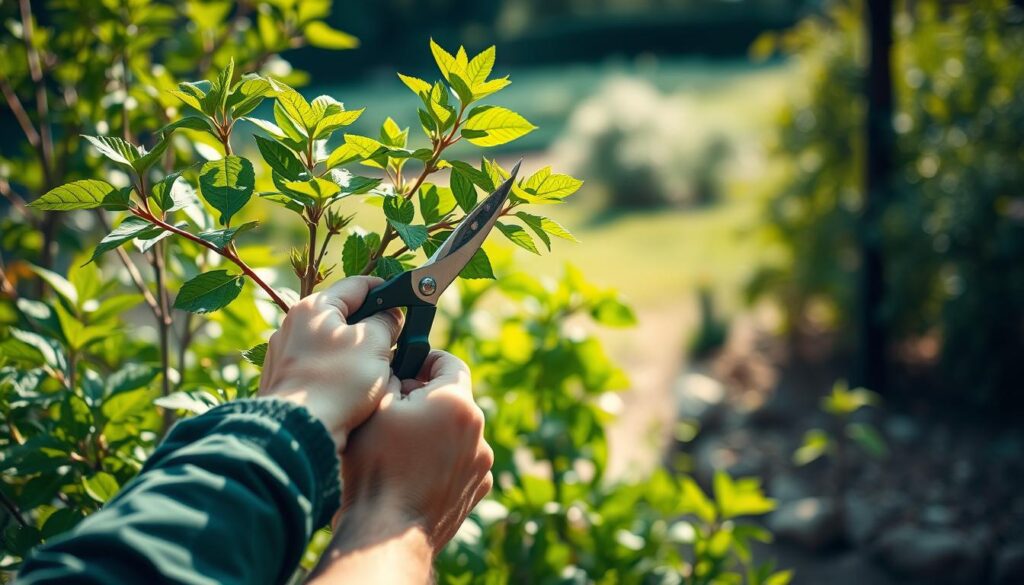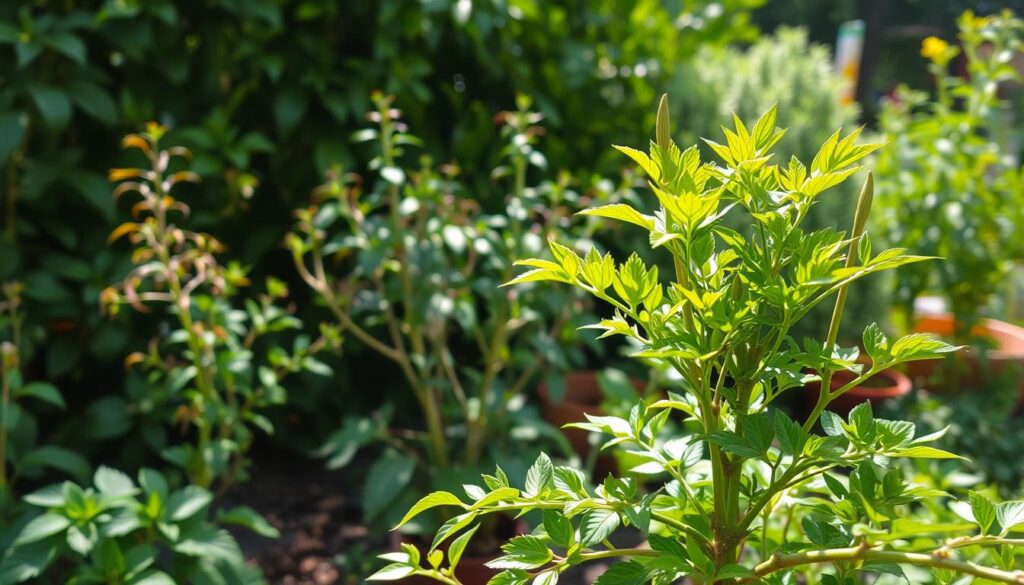Master Pruning Techniques for Healthy Plants

About the Game
Mastering effective pruning is key for healthy plants in gardening. It revives overgrown areas and makes your garden look great. Skilled pruning boosts growth and fights diseases. By using different pruning methods, your garden will bloom.
The Essential Role of Pruning in Plant Health
Pruning is very important for gardeners who want their plants to reach full potential. It’s not just about making plants look good; it’s crucial for their health. Regular pruning helps plants thrive, bringing more flowers and fruits.

Anúncios
Pruning gets rid of dead or sick branches that can stop growth. This helps plants grow new parts and stay healthy. It also prevents diseases by allowing more air to flow through.
Regular pruning leads to a healthier and more beautiful garden.
Anúncios
Why Pruning is Crucial for Gardeners
Pruning keeps gardens healthy and looking their best. It shows the gardener’s hard work and care. It supports the balance of nature in the garden too.
Benefits of Regular Pruning
- Promotes healthy growth by removing unhealthy branches.
- Encourages more flowers and fruits.
- Improves air circulation, reducing the risk of diseases.
- Shapes and organizes plants for a neater aesthetic.
By pruning regularly, gardeners can take good care of their plants. This is key for those who love gardening and want a thriving garden.
Understanding Common Pruning Myths
Many gardeners face various pruning myths that can harm their plants. Knowing the truth about these myths is key. It improves your pruning and helps your plants stay healthy and strong.
Myth: More Cuts Mean More Blooms
There’s a common belief that cutting plants more will cause them to bloom more. However, this isn’t always true. Pruning too much can actually stress the plants. It can stop them from blooming well. It’s important to learn the right amount to prune for the best growth.
Myth: You Can Prune Anytime
Some people think you can prune plants whenever you want. But, not all plants can handle pruning at any time. Pruning at the wrong time can really harm a plant. Knowing the best time to prune is crucial for keeping your garden healthy.
When to Prune: Timing for Optimal Results
Knowing when to prune is essential for your garden’s health. Each season has its own set of rules for pruning. Doing it right boosts flowering, increases yields, and keeps plants strong.
Spring Pruning Techniques
Spring is great for fixing winter damage and spurring growth. Trim away dead or hurt branches to welcome new growth. Shape your plants to keep air moving, reducing disease risk. This is crucial for plants that flower on last year’s branches.
Summer Pruning Considerations
In summer, focus on light cutting to keep plants neat and encourage more blooms. Remove old flowers and any big growth. Aim to manage plant size without overdoing it, as too much pruning can stress plants. Light pruning in summer helps blooms keep coming and leaves looking fresh.
Winter Pruning Strategies
Winter is time for major pruning, as plants are resting. Get rid of dead or disease-ridden branches, cutting above healthy buds. Pruning in winter means less stress for the plant, paving the way for strong spring growth. Pruning in winter helps your garden thrive.
Master Pruning Techniques: Tailored Approaches for Different Plants
Understanding different plants and their needs is key to effective pruning. Tailored techniques help your garden grow healthy and look beautiful. Trees and shrubs, for example, need specific shaping and structural work. This keeps them balanced, healthy, and nice to look at.
Flowering plants, on the other hand, need special care about their bloom times. Removing old flowers, a process called deadheading, helps them bloom more. This helps the plant focus energy on making new flowers, not seeds.
Fruit plants need a special focus on getting enough light and air. Proper pruning boosts both the quantity and quality of the fruit. The right pruning methods also help branches become stronger. This lets them carry more fruit and reduces disease by improving air circulation. Using the right pruning methods is critical for a thriving garden.
Tools of the Trade: Essential Pruning Equipment
Having the right tools for pruning is key for good gardening. Each tool has a special function. Learning their uses and how to keep them in shape is vital. This part talks about the main tools for pruning and how to take care of them. This ensures they last longer and work well.
Hand Pruners and Their Uses
Hand pruners are vital for anyone who gardens. They’re used for clean cuts on little branches and stems. They’re perfect for shaping plants, removing dead flowers, and trimming shrubs. When picking hand pruners, go for ones with comfy handles and sharp blades. This makes them easier to use and helps make better cuts.
Loppers for Thicker Branches
Loppers are bigger than hand pruners and help cut thicker branches. They have long handles to give more reach and power. This makes them great for cutting big shrubs and small trees. Like with hand pruners, sharp blades in loppers make cutting smoother and more efficient.
Maintaining Your Pruning Tools
To keep your pruning tools working great, regular care is needed. Here are some tips to keep your tools ready:
- Clean your tools after each use to stop diseases from spreading between plants.
- Sharpen the blades now and then for clean cuts, helping plants heal quicker.
- Keep tools in a dry place to avoid rust and damage.
The Impact of Climate on Pruning Strategies
It’s vital to understand how climate influences pruning for plant health. The local weather plays a big role in choosing when and how to prune. Gardeners need to think about the climate to keep their plants healthy and growing well.
In places with clear seasons like Glenside, Pennsylvania, the timing matters a lot. The area’s humid summers might require different methods than its cold, unpredictable winters. Looking at tree and shrub conditions as seasons change helps avoid stress from weather shifts.
How Humidity and Temperature Affect Timing
Changing humidity levels and temperatures affect when plants grow. This means gardeners need to change how they prune. High humidity can make some plants grow fast, needing more cuts. Pruning when it’s very cold can hurt plants.
- Schedule pruning after the last frost in spring to prevent damage.
- Monitor summer growth to determine when to prune for optimal health.
- Avoid cutting during extremely cold spells to protect plant integrity.
Pruning in Glenside, Pennsylvania: Local Considerations
Gardeners in Glenside should consider the local weather. The area has humid summers and cold, snowy winters. Knowing the needs of local plants helps create good pruning plans.
- Prune flowering trees right after blooming to promote future growth.
- Consider winterizing plants before the onset of harsh weather conditions.
- Utilize fall pruning for shaping and maintenance without excessive stress.
Avoiding Common Pruning Mistakes
Pruning is key to keeping plants healthy, but many make common mistakes. Learning the right way to prune protects plants from harm. This includes the risk of over-pruning and the damage caused by topping trees.
Over-Pruning: Recognizing the Signs
It’s easy to spot over-pruning. Look for plants that seem thin, weak, or have yellow leaves. This indicates too much has been cut away. Removing too many branches takes away the plant’s essential energy. This can leave the plant weak and open to diseases and pests.
The Dangers of Topping Trees
Topping trees by cutting off their tops has serious consequences. It causes an unnatural shape and weak, thin growth. Trees become easy targets for wind damage. They also may not live as long. Choose pruning methods that support healthy growth for better landscaping results.
Cutting Techniques for Effective Pruning
It’s crucial to know the different pruning cuts for healthy plants. Various methods affect a plant’s health and structure differently. Heading and thinning cuts are common. They each have specific roles and need careful use for the best results.
Types of Pruning Cuts: Heading vs. Thinning
Heading cuts shorten branch tips to boost bushier growth. They trigger new shoots near the cut. This method is great for shaping and controlling a shrub’s size. Thinning cuts, however, remove branches entirely to their base. They enhance air flow, light reach, and the plant’s shape.
Making Clean Cuts for Faster Healing
Clean cuts are vital, no matter which method you use. They heal quicker and fight off disease. Use sharp tools for smooth cuts. This avoids damage. Dull tools can harm the plant, causing dieback or disease. Good cutting skills make for healthier, happier plants.
Preparing Young Plants for the Future
Pruning young plants is very important for their growth. It helps them grow strong and look good. By pruning properly and training them, we make sure they grow up healthy and strong.
Initial Pruning Practices
Pruning young plants needs careful planning. Here’s what to do:
- Remove any dead or damaged branches to keep them healthy.
- Thin out crowded areas for better air and sunlight.
- Make sure there’s a strong central leader for upward growth.
Training Young Trees and Shrubs
How we train young plants shapes their future. Here are some strategies:
- Use stakes or supports to help them grow straight.
- Check and adjust branch positions for even growth.
- Cut back weak branches to focus growth on the strong ones.
Special Techniques for Specific Plant Types
Every garden has plants that need specific care. For flowering plants and fruit trees, knowing how to prune properly is key. If you prune flowers the right way, you get bright, beautiful blooms and healthy growth. On the flip side, pruning fruit trees aims to boost their fruit and keep them strong.
Pruning Flowering Plants for Maximum Blooms
Flowering plants thrive with careful pruning. Here’s how:
- Removing dead or diseased branches to promote healthy growth.
- Cutting back stems after the blooming season to stimulate new growth points for more flowers.
- Using selective thinning for denser bushy plants, granting better air circulation.
Using these tips at the right time will make your blooms stand out.
Fruit Tree Pruning: Enhancing Harvests
Pruning fruit trees is about both growth and better produce. Keep these in mind:
- Cutting back excessive branches to allow sunlight to penetrate can improve fruit ripening.
- Removing suckers and water sprouts helps direct energy to fruit-bearing branches.
- Pruning during the dormant season allows trees to heal before the growing season begins.
With these techniques, you can look forward to plenty of fruit while keeping your trees healthy.
Conclusion
Mastering pruning is key for successful gardening and keeping plants healthy. Learn when to cut and how to handle different plants. This helps your garden look good and stay strong.
Our guide reminds you of the right techniques and tools. They shape your garden’s look and its yield. By avoiding mistakes and following best practices, gardeners at any level can do better.
So, as we end our guide on plant care, remember what you’ve learned. Pruning well means a healthier, more beautiful garden for the future. With the right knowledge, your garden will thrive.
FAQ
Why is pruning important for plant health?
What are some common myths about pruning?
When is the best time to prune plants?
What tools do I need for effective pruning?
How does climate affect pruning practices?
What are common mistakes to avoid when pruning?
What different pruning cuts should I know about?
How should I prune young plants?
Are there specific techniques for flowering plants and fruit trees?
Game Details
No
No